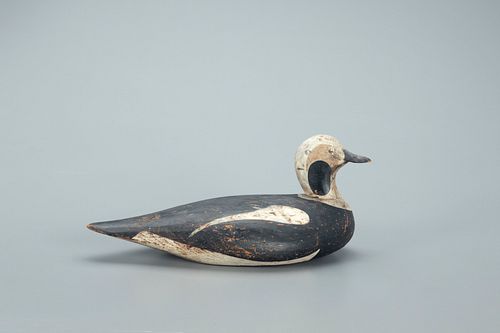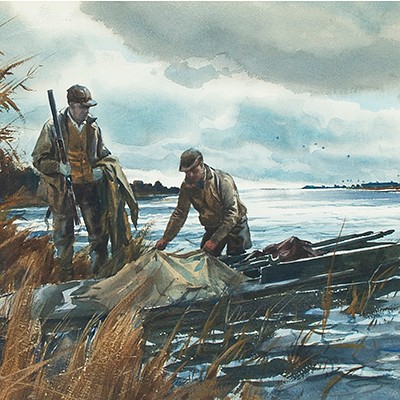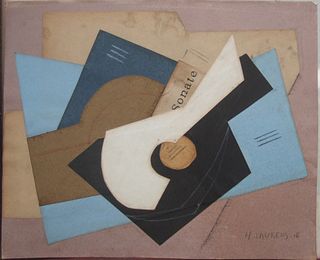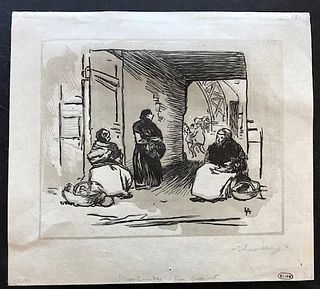Turned-Head Long-Tail Drake Decoy, Orlando "Os" Bibber (1882-1970)
About Seller
20 Winter Street
Pembroke, MA 02359
United States
Founded in 2005, Copley Fine Art Auctions is a boutique auction house specializing in antique decoys and American, sporting, and wildlife paintings. Over the course of the last two decades, the firm has set auction records for not only individual decoy makers, but also entire carving regions. Copley...Read more
Two ways to bid:
- Leave a max absentee bid and the platform will bid on your behalf up to your maximum bid during the live auction.
- Bid live during the auction and your bids will be submitted real-time to the auctioneer.
Bid Increments
| Price | Bid Increment |
|---|---|
| $0 | $50 |
| $1,000 | $100 |
| $2,500 | $250 |
| $5,000 | $500 |
| $10,000 | $1,000 |
| $25,000 | $2,500 |
| $50,000 | $5,000 |
About Auction
Mar 5, 2022
Lots 265-556 Copley Fine Art Auctions cinnie@copleyart.com
- Lot Description
Turned-Head Long-Tail Drake
Orlando "Os" Bibber (1882-1970)
South Harpswell, ME, c. 1910
16 in. long
"Bibber's birds are the best carvings on the coast.” — John Dinan, "The Great Book of Wildfowl Decoys"
This turned-head long-tailed drake was carved by renowned Maine maker "Os" Bibber. In "Bird Decoys of North America," author Robert Shaw writes, “[Bibber was] a sophisticated man who worked as a chief engineer on steamships that ran from Portland to New Brunswick and often as far south as Cuba. Known as Os or Ollie, he made decoys that are atypical of the Maine coast...He was apparently a fastidious man who, unlike Huey, made decoys only for his own use and devoted considerable time to their making.”
This decoy is a closely related rigmate to the iconic Bibber long-tailed drake which was also held in the Johnson Collection. It displays fine head carving and a long and wide body that finishes with elegant elongated lines. Bibber’s deceptively simple paint pattern has produced an exceptional minimalist presentation of this sleek sea duck species.
Original paint with moderate gunning wear.
Provenance: Linda Johnson Collection
Literature: Joe Engers, ed., "The Great Book of Wildfowl Decoys," Lewes, DE, 1990, pp. 33-35. related decoy illustrated. Guyette & Schmidt Inc., "North American Decoys at Auction," St. Michaels, MD, July 29 and 30, 2006, lot 83, p. 29, related example with touch-up to flaking illustrated. Robert Shaw, "Bird Decoys of North America," New York, NY, 2010, pp. 62, 145-146, related example illustrated and discussed. Copley Fine Art Auctions, "The Sporting Sale 2010," Plymouth, MA, July 22-23, 2010, lot 726, related hen illustrated. Copley Fine Art Auctions, “The Johnson Collection of American Bird Decoys, The Sporting Sale 2021,” Hingham, MA, July 9, 2021, back cover and lot 22, rigmate illustrated.Please email condition report requests to colin@copleyart.com. Any condition statement given is a courtesy to customers, Copley will not be held responsible for any errors or omissions. The absence of a condition statement does not imply that the lot is in perfect condition.Condition
- Shipping Info
-
Copley Fine Art Auctions does not handle the shipping of any items. Shipping is the sole responsibility of the buyer. Once your payment has cleared, and we have received your authorized shipping release form items may be released for shipment. Copley Fine Art Auctions, LLC shall have no liability for any loss or damage to such items. Buyers should allow up to four weeks for shipment.
-



 EUR
EUR CAD
CAD AUD
AUD GBP
GBP MXN
MXN HKD
HKD CNY
CNY MYR
MYR SEK
SEK SGD
SGD CHF
CHF THB
THB














